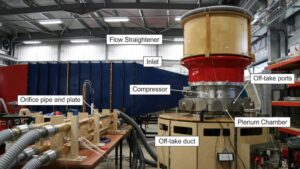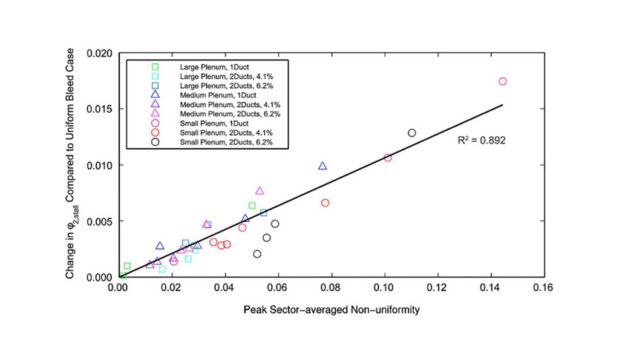Overview
Pressurised air for cooling is extracted from the compressor through a number off-take ducts; reducing the number of off-takes makes assembly and maintenance of gas turbines easier but induces distortion in the compressor.
The bleed rates of interest are representative of design operating conditions and vary between 0 and 6% of the main passage mass flow rate. The aim of the work is to provide a conceptual understanding of the effect of uniform and non-uniform bleed on the main annulus flow and how this affects the performance of a downstream compressor stage, including its operating range. The second aim is quantify the effect of bleed rate and bleed system configuration on loss in the bleed system. Single-stage axial compressor rig tests using the Red Compressor (Fig. 1) and CFD calculations were employed to meet these aims. Circumferentially uniform bleed extraction is shown to have a small effect on the spanwise distribution of flow upstream and downstream of the bleed slot. Pressure rise and efficiency characteristics, for different bleed rates, collapse towards one line when plotted against stage inlet flow coefficient. The small changes in spanwise distribution with bleed do, however, reduce incidence locally at the rotor tip by up to 1 degree and this improves operating range by up to 3.8% as bleed rate is increased.
Non-uniform bleed extraction leads to a circumferential distribution of flow coefficient and flow angle upstream and downstream of the bleed slot. The resultant distribution of rotor incidence at stage inlet causes operating range to reduce by up to 4.9% compared to uniform bleed extraction at the same bleed rate. The circumferential distribution of bleed in the slot is measured and used as a proxy for the non-uniform flow at stage inlet. Figure 2 shows that the loss of operating range caused by non-uniform bleed correlates with the “peak sector-averaged bleed non-uniformity”. This new parameter takes inspiration from the DC(θcrit) method used to characterise stagnation pressure inlet distortion tests.
For uniform bleed, CFD shows that 67% of bleed system loss occurs in the bleed slot, 25% in the plenum chamber and 8% in the off-take duct. A loss coefficient is defined which is found to be constant for the uniform bleed rates tested and increases as bleed system non-uniformity increases. For different configurations this loss coefficient is shown to correlate with slot velocity cubed.
Two papers have been published describing this work: Bleed Induced Distortion in Axial Compressors, Grimshaw et al. Journal of Turbomachinery (2015) Vol. 137, Issue 9, Article 101009 and Modeling Nonuniform Bleed in Axial Compressors, Grimshaw et al. Journal of Turbomachinery (2016) Vol. 138, Issue 9, Article 091010.
Associated Team

